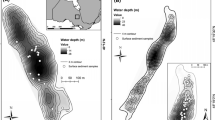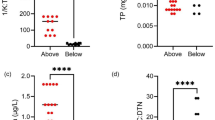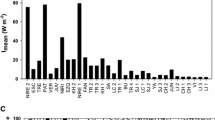Abstract
Changing environmental conditions in the Arctic have caused widespread but disparate changes in the relative abundances of diatoms in the Cyclotella sensu lato group since 1850 across Arctic lakes. To better understand the mechanisms behind these species changes, we investigated how the nutrient limitation status of a lake alters the responses of three common Cyclotella sensu lato taxa to light. To assess this, we collected source water with the natural phytoplankton assemblages from lakes in southwest Greenland with different nutrient limitation status (phosphorus (P)-limited or nitrogen & phosphorus (N&P) co-limited). The responses of Lindavia bodanica, Lindavia radiosa, and Discostella stelligera to light levels (low, moderate, or high) and nutrients (limited or replete) were tested using a factorial design. The vertical distributions of these taxa across 20 lakes of varying nutrient limitation status and water transparency were also assessed. We found that light affected Cyclotella growth rates, cell densities, and distribution patterns differently depending on lake nutrient limitation status. L. bodanica fared best at low light under P-limitation, and at high light under N&P co-limitation, while the pattern was generally opposite for D. stelligera. For L. radiosa, regardless of nutrient limitation status, moderate-to-high light was important, with this species absent from lakes with lower light conditions. This study reveals that environmental change affects these species via complex interactions between nutrient and light availability, and helps to clarify some of the complex distribution patterns of planktonic diatom taxa found in lakes of many areas around the Arctic as well as at lower latitudes.




Similar content being viewed by others
References
Anderson JN, Stedmon CA (2007) The effect of evapoconcentration on dissolved organic carbon concentration and quality in lakes of SW Greenland. Freshw Biol 52:280–289
Anderson NJ, Harriman R, Ryves DB, Patrick ST (2001) Dominant factors controlling variability in the ionic composition of west Greenland lakes. Arct Antarct Alp Res 33:418–425
Ask J, Karlsson J, Persson L, Ask P, Byström P, Jansson M (2009) Terrestrial organic matter and light penetration: effects on bacterial and primary production in lakes. Limnol Oceanogr 54:2034–2040. doi:10.4319/lo.2009.54.6.2034
Bergström AK (2010) The use of TN:TP and DIN:TP ratios as indicators for phytoplankton nutrient limitation in oligo- trophic lakes affected by N deposition. Aquat Sci 72:277–281. doi:10.1007/s00027-010-0132-0
Boeff KA, Strock KE, Saros JE (2016) Evaluating planktonic diatom response to climate change across three lakes with differing morphometry. J Paleolimnol 56:33–47. doi:10.1007/s10933-016-9889-z
Brutemark A, Rengefors K, Anderson NJ (2006) An experimental investigation of phytoplankton nutrient limitation in two contrasting low Arctic lakes. Polar Biol 29:487–494
Canham CD, Pace ML, Papaik MJ, Primack AGB, Roy KM, Maranger RJ, Curran RP, Spada DM (2004) A spatially explicit watershed-scale analysis of dissolved organic carbon in Adirondack lakes. Ecol Appl 14(3):839–854
Cole JJ (2009) Production in pristine lakes. Nature 460:463–464. doi:10.1038/460463a
Daley RJ, Brown SR (1973) Chlorophyll, nitrogen and photosynthetic patterns during growth and senescenceof two blue- green algae. J Phycol 9:395–401. doi:10.1111/j.1529-8817.1973.tb04112.x
Falkowski PG, Raven JA (2007) Light absorption and energy transfer in the photosynthetic apparatus 44. Aquatic photosynthesis, 2nd edn. Princeton University Press, Princeton, pp 44–80
Fee EJ, Hecky RE, Kasian SEM, Cruikshank DR (1996) Effects of lake size, water clarity, and climatic variability on mixing depths in Canadian Shield lakes. Limnol Oceanogr 41(5):912–920. doi:10.4319/lo.1996.41.5.0912
Finkel ZV (2001) Light absorption and size scaling of light-limited metabolism in marine diatoms. Limnol Oceanogr 46:86–94
Finkel ZV, Irwin AJ, Schofield O (2004) Resource limitation alters the 3/4 size scaling of metabolic rates in phytoplankton. Mar Ecol Progr Ser 273:269–279
Frey KE, McClelland JW (2009) Impacts of permafrost degradation on Arctic river biogeo- chemistry. Hydrol Process 23:169–182
Fritz SC, Anderson NJ (2013) The relative influences of climate and catchment processes on Holocene lake development in glaciated regions. J Paleolimnol 49:349–362. doi:10.1007/s10933-013-9684-z
Gregory-Eaves I, Smol JP, Finney BP, Lean DRS, Edwards E (2000) Characteristics and variation in lakes along a north-south transect in Alaska. Fundam Appl Limnol 147:193–223
Hogan EJ, McGowan S, Anderson NJ (2014) Nutrient limitation of periphyton growth in Arctic lakes in south-west Greenland. Polar Biol 37:1331–1342
Holtgrieve GW, Schindler DE, Hobbs WO, Leavitt PR, Ward EJ, Bunting L, Chen G, Finney BP, Gregory-Eaves I, Holmgren S, Lisac MJ, Lisi PJ, Nydick K, Rogers LA, Saros JE, Selbie DT, Shapley MD, Walsh PB, Wolfe AP (2011) A coherent signature of anthropogenic nitrogen deposition to remote watersheds of the northern hemisphere. Science 334:1545–1548
Horn H, Paul L, Horn W, Petzolt T (2011) Long-term trends in the diatom composition of the spring bloom of a German reservoir: is Aulacoseira subarctica favored by warm winters? Freshw Biol 56:2483–2499
Houk V, Klee R (2004) The stelligeroid taxa of the genus Cyclotella (Kutz.) Brebisson (Bacillariophyceae) and their transfer to the new genus Discostella gen. nov. Diatom Res 19:203–228
Interlandi SJ, Kilham SS, Theriot EC (1999) Responses of phytoplankton to varied resource availability in large lakes of the Greater Yellowstone Ecosystem. Limnol Oceanogr 44:668–682
Kardinaal WEA, Tonk L, Janse I, Hol S, Huisman J, Visser PM (2007) Competition for light between toxic and non-toxic strains of the harmful cyanobacterium Microcystis. Appl Environ Microbiol 73:2939–2946
Karlsson J, Byström P, Ask J, Ask P, Persson L, Jansson M (2009) Light limitation of nutrient-poor lake ecosystems. Nature 460:506–509. doi:10.1038/nature08179
Key T, McCarthy A, Campbell DA, Six C, Roy S, Finkel ZV (2010) Cell size trade-offs govern light exploitation strategies in marine phytoplankton. Environ Microbiol 12:95–104
Kraemer BM, Anneville O, Chandra S, Dix M, Kuusisto E, Livingstone DM, Rimmer A, Schladow SG, Silow E, Sitoki LM, Tamatamah R, Vadeboncoeur Y, Mclntyre PB (2015) Morphometry and average temperature affect lake stratification responses to climate change. Geophys Res Lett 42:4981–4988. doi:10.1002/2015GL064097
Larkum A, Barett J (1983) Light harvesting processes in algae. Adv Bot Res 10:1–219
Law AC, Anderson NJ, McGowan S (2015) Spatial and temporal variability of lake ontogeny in south-western Greenland. Quat Sci Rev 126:1–16
Lepetit B, Goss R, Jakob T, Wilhelm C (2012) Molecular dynamics of the diatom thylakoid membrane under different light conditions. Photosynth Res 111:245–257. doi:10.1007/s11120-011-9633-5 PMID:21327535
Levine MA, Whalen SC (2001) Nutrient limitation of phytoplankton production in Alaskan Arctic foothill lakes. Hydrobiologia 455:189–201
Litchman E (1998) Population and community responses of phytoplankton to fluctuating light. Oecologia 117:247–257
Litchman E (2003) Competition and coexistence of phytoplankton under fluctuation light: experiments with two cyanobacteria. Aquat Microb Ecol 31:241–248
Malik HI, Saros JE (2016) Effects of temperature, light and nutrients on five Cyclotella sensu lato taxa assessed with in situ experiments in Arctic lakes. J Plankton Res 38(3):431–442. doi:10.1093/plankt/fbw002
Markager S, Vincent WF, Tang EPY (1999) Carbon fixation in high Arctic lake: implications of low temperature for photosynthesis. 44:597–607. Limnol Oceanogr 44:597–607
Miller MC, Hatter GR, Spatt P, Westlake P, Yeakel D (1986) Primary production and its control in Toolik Lake. Alaska Fundam Appl Limnol 74:97–131
Nakov T, Guillory WX, Julius ML, Theriot EC, Alverson AJ (2015) Towards a phylogenetic classification of species belonging to the diatom genus Cyclotella (Bacillariophyceae): transfer of species formerly placed in Puncticulata, Handmannia, Pliocaenicus and Cyclotella to the genus Lindavia. Phytotaxa 217:249–264
Noble PJ, Chandra S, Kreamer DK (2013) Dynamics of phytoplankton distribution in relation to stratification and winter precipitation, Fallen Leaf Lake, California. West N Am Nat 73:302–322
Ogbebo E, Evans MS, Waiser MJ, Tumber VP, Keating JJ (2009) Nutrient limitation of phytoplankton growth in Arctic lakes of the lower Mackenzie River Basin, northern Canada. Can J Fish Aquat Sci 66:247–260
Passarge L, Hol S, Escher M, Huisman J (2006) Competition for nutrients and light: stable coexistence, alternative stable states or competitive exclusion? Ecol Monogr 76:57–72
Perren BB, Douglas MSV, Anderson NJ (2009) Diatoms reveal complex spatial and temporal patterns of recent limnological change in West Greenland. J Paleolimnol 42:233–247
Perren BB, Anderson NJ, Douglas MSV, Fritz SC (2012) The influence of temperature, moisture, and eolian activity on Holocene lake development in West Greenland. J Paleolimnol 48:223–239
Porra RJ, Grimme LH (1974) Chlorophyll synthesis and intracellular fluctuations of 5-aminolaevulinate formation during regreening of nitrogen-deficient Chlorella fusca. Arch Biochem Biophys 148:37–43
Reyes FR, Lougheed VL (2015) Rapid nutrient release from permafrost thaw in Arctic aquatic ecosystems. Arct Antarct and Alp Res 47:35–48
Reynolds CS (1984) The ecology of freshwater phytoplankton. Cambridge University Press, Cambridge
Rigler FH (1978) Limnology in the Arctic: a case study of Char Lake. Proc Int Assoc Theor Appl Limnol (SIL) 20:127–140
Rippey B, Anderson NJ, Foy RH (1997) Accuracy of diatom-inferred total phosphorus concentrations and the accelerated eutrophication of a lake due to reduced flushing and increased internal loading. Can J Fish Aquat Sci 54:2637–2646
Saros JE, Stone JR, Pederson GT, Slemmons KEH, Spanbauer T, Schliep A, Cahl D, Williamson CE, Engstrom DR (2012) Climate-induced changes in lake ecosystem structure inferred from coupled neo- and paleo-ecological approaches. Ecology 93:2155–2164
Saros JE, Strock KE, Mccue J, Hogan E, Anderson NJ (2014) Response of Cyclotella species to nutrients and incubation depth in Arctic lakes. J Plankton Res 36(2):450–460
Saros JE, Osburn CL, Northington RM, Birkel SD, Auger JD, Stedmon CA, Anderson NJ (2015) Recent decrease in DOC concentrations in Arctic lakes of southwest Greenland. Geophys Res Lett 42:6703–6709. doi:10.1002/2015GL065075
Saros JE, Northington RM, Osburn CL, Anderson NJ (2016) Thermal stratification in small Arctic lakes of southwest Greenland affected by water transparency and epilimnetic temperatures: thermal Stratification of Arctic Lakes. Limnol Oceanogr 61:1530–1542
Schindler DW, Welch HE, Kalff J, Brunskdl GJ, Kritsch N (1974) Physical and chemical limnology of Char Lake, Cornwallis Island (75°N Lat.). J Fish Res Board Can 31:585–607
Schuur EAG, McGuire AD, Schädel C, Grosse G, Harden JW, Hayes DJ, Hugelius G, Koven CD, Kuhry P, Lawrence DM, Natali SM, Olefeldt D, Romanovsky VE, Schaefer K, Turetsky MR, Treat CC, Vonk JE (2015) Climate change and the permafrost carbon feedback. Nature 520:171–179
Seekell DA, Lapierre JF, Pace ML, Gudasz C, Sobel S, Tranvik LJ (2014) Regional-scale variation of dissolved organic carbon concentrations in Swedish lakes. Limnol Oceanogr 59:1612–1620
Silsbe GM, Smith REH, Twiss MR (2015) Quantum efficiency of phytoplankton photochemistry measured continuously across gradients of nutrients and biomass in Lake Erie (Canada and USA) is strongly regulated by light but not by nutrient deficiency. Can J Fish Aquat Sci 72:651–660
Smol JP, Wolfe AP, Birks HJB, Douglas MSV, Jones VJ, Korhola A, Pienitz R, Rühland K, Sorvari S, Antoniades D, Brooks SJ, Fallu M, Hughes M, Keatley BE, Laing TE, Michelutti N, Nazarova L, Nyman M, Paterson AM, Perren B, Quinlan R, Rautio M, Saulnier-Talbot E, Siitonen S, Solovieva N, Weckström J (2005) Climate-driven regime shifts in the biological communities of Arctic lakes. Proc Natl Acad Sci USA 102:4397–4402
Snucins E, Gunn J (2000) Interannual variation in the thermal structure of clear and colored lakes. Limnol Oceanogr 45:1639–1646
Striegl RG, Aiken GR, Dornblaser MM, Raymond PA, Wickland KP (2005) A decrease in discharge-normalized DOC export by the Yukon River during summer through autumn. Geophys Res Lett 32:L21413. doi:10.1029/2005GL024413
Surdu MC, Duguay CR, Brown LC, Fernández Prieto D (2014) Response of ice cover on shallow lakes of the North Slope of Alaska to contemporary climate conditions (1950–2011): radar remote-sensing and numerical modeling data analysis. The Cryosphere 8:167–180
Surdu MC, Duguay CR, Brown LC, Fernández Prieto D (2016) Evidence of recent changes in the ice regime of lakes in the Canadian High Arctic from spaceborne satellite observations. The Cryosphere 10:941–960
Symons CC, Arnott SE, Sweeetman JN (2012) Nutrient limitation of phytoplankton communities in Subarctic lakes and ponds in Wapusk National Park, Canada. Polar Biol 35(4):481–489
Syrett PJ (1981) Nitrogen metabolism of microalgae. Can Bull Fish Aqua Sci 182–210
Tolotti M, Thies H, Nickus U, Psenner R (2012) Temperature modulated effects of nutrients on phytoplankton changes in a mountain lake. Hydrobiologia 698:61–75
Townsend-Small A, McClelland JW, Holmes RM, Peterson BJ (2011) Seasonal and hydrologic drivers of dissolved organic matter and nutrients in the upper Kuparuk River, Alaskan Arctic. Biogeochemistry 103:109–124. doi:10.1007/s10533-010-9451-4
Weyhenmeyer GA, Karlsson J (2009) Nonlinear response of dissolved organic carbon concentrations in boreal lakes to increasing temperatures. Limnol Oceanogr 54(6):2513–2519
Whiteford E, McGowan S, Barry CD, Anderson NJ (2016) Seasonal and regional controls of phytoplankton production along a climate gradient in South-West Greenland during ice-cover and ice-free conditions. Arct Antarct Alp Res 48(1):139–159. doi:10.1657/AAAR0015-003
Williamson CE, Morris DP, Pace ML, Olson OG (1999) Dissolved organic carbon and nutrients as regulators of lake ecosystems: resurrection of a more integrated paradigm. Limnol Oceanogr 44:795–803
Winder M, Hunter DA (2008) Temporal organization of phytoplankton communities linked to physical forcing. Oecologia 156:179–192
Acknowledgements
This research was funded by the Arctic System Science program of the US National Science Foundation (Grant #1203434 to JES). CH2 M Hill Polar Services provided logistical support for this project. We thank Kathryn Warner for field and laboratory assistance, and Nicholas John Anderson for providing the growth chamber and key pilot data for this project.
Author information
Authors and Affiliations
Corresponding author
Rights and permissions
About this article
Cite this article
Malik, H.I., Northington, R.M. & Saros, J.E. Nutrient limitation status of Arctic lakes affects the responses of Cyclotella sensu lato diatom species to light: implications for distribution patterns. Polar Biol 40, 2445–2456 (2017). https://doi.org/10.1007/s00300-017-2156-6
Received:
Revised:
Accepted:
Published:
Issue Date:
DOI: https://doi.org/10.1007/s00300-017-2156-6




